Neil Prior
BBC News
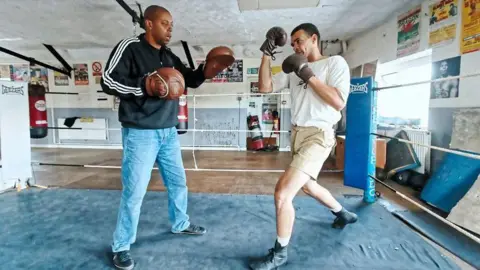
BBC News

Theatr na nÓg
Kev McCurdy taught boxing moves to the cast
One of boxing's most shameful chapters will be retold in a new play.
Cuthbert Taylor was born in Merthyr Tydfil in 1909 and competed for Great Britain in the 1928 Amsterdam Olympics.
But he was denied the right to fight for the British title because of the colour of his skin and, because his father was of Caribbean heritage, the British Boxing Board of Control, (BBBoC) deemed him "not white enough" to be British.
Now his story and that of the boxing's colour bar is being brought to life by director Kev McCurdy in The Fight.
Under the BBBoC’s colour bar, which ran from 1911 to 1948, boxers had to have been born to two white parents.
In a 20-year professional career Cuthbert won 151 bouts, drew 22 and lost 69.
The bantamweight and lightweight sold out Liverpool’s Anfield stadium for a drawn fight against US world champion Freddy Miller in aid of the 1935 Gresford Colliery disaster.
Yet even at the Olympics a referee officiated one of Cuthbert’s fights from outside of the ring as he did not want to come into contact with a black man.
Kev McCurdy taught boxing moves to the cast
One of boxing's most shameful chapters will be retold in a new play.
Cuthbert Taylor was born in Merthyr Tydfil in 1909 and competed for Great Britain in the 1928 Amsterdam Olympics.
But he was denied the right to fight for the British title because of the colour of his skin and, because his father was of Caribbean heritage, the British Boxing Board of Control, (BBBoC) deemed him "not white enough" to be British.
Now his story and that of the boxing's colour bar is being brought to life by director Kev McCurdy in The Fight.
Under the BBBoC’s colour bar, which ran from 1911 to 1948, boxers had to have been born to two white parents.
In a 20-year professional career Cuthbert won 151 bouts, drew 22 and lost 69.
The bantamweight and lightweight sold out Liverpool’s Anfield stadium for a drawn fight against US world champion Freddy Miller in aid of the 1935 Gresford Colliery disaster.
Yet even at the Olympics a referee officiated one of Cuthbert’s fights from outside of the ring as he did not want to come into contact with a black man.
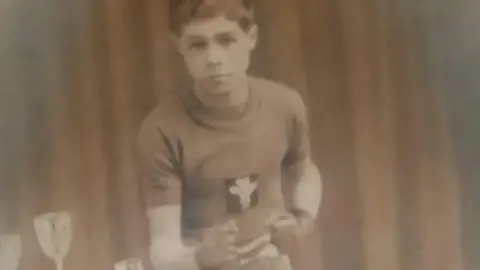
Family photo
Cuthbert fought at the 1928 Olympics and had about 250 professional bouts
Cuthbert fought at the 1928 Olympics and had about 250 professional bouts
Cuthbert’s grandson, Nick Taylor, said the pain of the injustice lingers to this day.
"It was bad enough that it happened then, but the fact that the BBBoC still refuse to apologise for it to this day is utterly shameful," he said.
"It shows that they just don’t get the harm their predecessors did.
"We’re not after money or compensation, all we want is an acknowledgement that the colour bar was wrong, so we can allow Cuthbert to rest in peace."
BBBoC has been asked to comment.
Boxer's family want historical colour bar apology
'The black sporting heroes who changed our lives'
The black sportswomen you should know more abou
Written by Geinor Styles and directed by McCurdy, The Fight, produced by Theatr na nÓg, will play to more than 5,000 school children across south Wales from September to November at Swansea’s Dylan Thomas Theatre and Theatr Brycheiniog in Brecon.
McCurdy, a fight choreographer, has worked on Hollywood blockbusters, Netflix programmes and the West End version of hit series Stranger Things.
Now, he is set on righting a century-old wrong with his production.
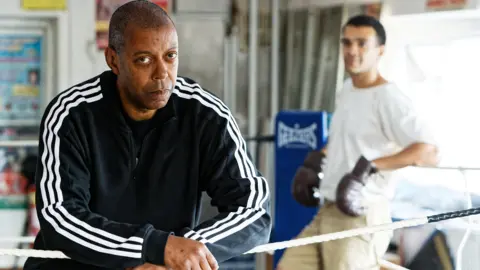
Theatr na nÓg
Kev McCurdy has choreographed fight scenes in Hollywood, for TV and on the West End
McCurdy – the only person of colour to become a qualified combat choreographer in the UK – has worked on films including Disney’s John Carter and TV series such as Doctor Who, Torchwood and Hinterland.
He hopes The Fight will "shake the dust out" of this story.
“It’s gone on far too long and it’s not just Cuthbert, it’s the same with quite a few of the other boxers of that era, such as Len Johnson," he said.
"That level of injustice because of the colour of your skin went to the very top of society. The policy was even endorsed by the Archbishop of Canterbury and Winston Churchill.
"I’m a glass half-full person but seeing as the BBBoC have failed to respond to three statements in Parliament, I’m not holding my breath."
McCurdy, who was fostered as a baby to a white family, believes Styles was wise to target her script at school-age children aged nine and above.
"Kids need to see people like them and to think critically about the effects of racism on all of us, while their minds are still open enough to entertain ideas," he said.
"We haven’t softened or dumbed down the story at all. We’re dealing with injustice, grief, love and social friendships. My kids have grown up now, but it's a fact, young people can actually handle a lot more than what we think."
Kev McCurdy has choreographed fight scenes in Hollywood, for TV and on the West End
McCurdy – the only person of colour to become a qualified combat choreographer in the UK – has worked on films including Disney’s John Carter and TV series such as Doctor Who, Torchwood and Hinterland.
He hopes The Fight will "shake the dust out" of this story.
“It’s gone on far too long and it’s not just Cuthbert, it’s the same with quite a few of the other boxers of that era, such as Len Johnson," he said.
"That level of injustice because of the colour of your skin went to the very top of society. The policy was even endorsed by the Archbishop of Canterbury and Winston Churchill.
"I’m a glass half-full person but seeing as the BBBoC have failed to respond to three statements in Parliament, I’m not holding my breath."
McCurdy, who was fostered as a baby to a white family, believes Styles was wise to target her script at school-age children aged nine and above.
"Kids need to see people like them and to think critically about the effects of racism on all of us, while their minds are still open enough to entertain ideas," he said.
"We haven’t softened or dumbed down the story at all. We’re dealing with injustice, grief, love and social friendships. My kids have grown up now, but it's a fact, young people can actually handle a lot more than what we think."
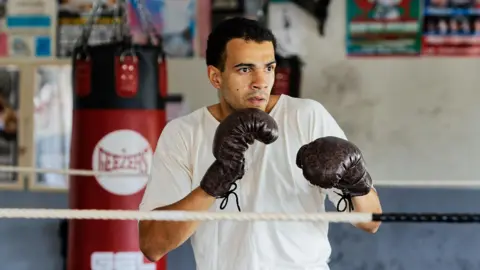
Theatr na nÓg
Simeon Desvignes, who plays Cuthbert, got boxing training as part of his preparation for the role
The bouts depicted in the play have been painstakingly reconstructed from newspaper reports of Cuthbert’s style, as well as the limited remaining photos and film.
But one of the biggest challenges was making the boxing scenes as believable as possible on stage.
"It's a lot easier in cinema and TV because you have body doubles and clever edits in post-production, but on the stage there’s nowhere to hide," said McCurdy.
"Of course we’re not fighting for real, but the actors all need to know how to box and understand the key moments so if they go wrong they can get back to a point where they can pick up the sequence again."
He added that performers do not hit each other hard, but the sound of the gloves aims to add realism.
Simeon Desvignes, who plays Cuthbert, got boxing training as part of his preparation for the role
The bouts depicted in the play have been painstakingly reconstructed from newspaper reports of Cuthbert’s style, as well as the limited remaining photos and film.
But one of the biggest challenges was making the boxing scenes as believable as possible on stage.
"It's a lot easier in cinema and TV because you have body doubles and clever edits in post-production, but on the stage there’s nowhere to hide," said McCurdy.
"Of course we’re not fighting for real, but the actors all need to know how to box and understand the key moments so if they go wrong they can get back to a point where they can pick up the sequence again."
He added that performers do not hit each other hard, but the sound of the gloves aims to add realism.
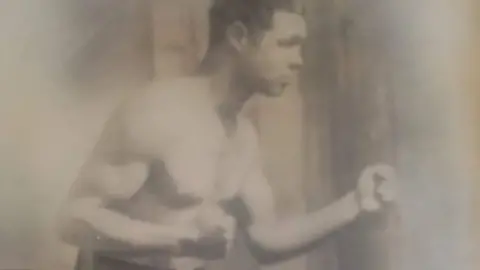
Family photo
Although injured in later life, Cuthbert remained a jolly character until his death
For Nick, there will always be a grampy behind the boxer - who died in 1977 when Nick was seven.
"I remember him as such a kind, loving grandfather," he said.
"My grandmother ran the local shop, so there’d always be plenty of sweets and even though Cuthbert had badly injured his legs in an accident at the Hoover factory, he was still a happy, uncomplaining family man."
The Fight has been developed in consultation with Show Racism the Red Card and - if successful - there has been tentative interest about turning it into a film.
Although injured in later life, Cuthbert remained a jolly character until his death
For Nick, there will always be a grampy behind the boxer - who died in 1977 when Nick was seven.
"I remember him as such a kind, loving grandfather," he said.
"My grandmother ran the local shop, so there’d always be plenty of sweets and even though Cuthbert had badly injured his legs in an accident at the Hoover factory, he was still a happy, uncomplaining family man."
The Fight has been developed in consultation with Show Racism the Red Card and - if successful - there has been tentative interest about turning it into a film.
No comments:
Post a Comment